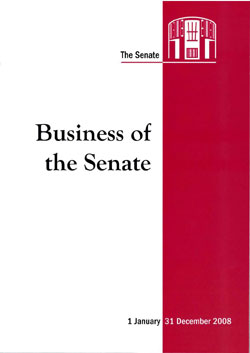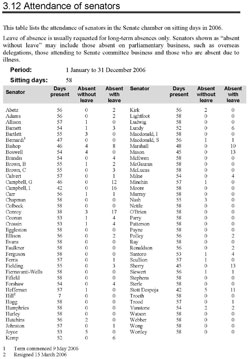47 Leave of absence to senators
-
Leave of absence may be given by the Senate to a senator on motion after notice, stating the cause and period of absence. The notice of motion shall have precedence as business of the Senate.
-
A senator shall be excused from service in the Senate or on a committee so long as the senator has leave of absence.
-
A senator having leave of absence shall forfeit it by attending the Senate before the expiration of the leave.
Amendment history
Adopted: 19 August 1903 as SOs 47, 48 and 49 (corresponding to paragraphs (1) to (3))
1989 revision: Old SOs 49 to 51 combined into one, structured as three paragraphs and renumbered as SO 47; some simplification of expression, removal of masculine pronouns and “priority over other Motions” re-expressed as “precedence as Business of the Senate”
Commentary

Business of the Senate is a biannula publication containing details of business transacted by the Senateduring the preceding period

Details of senators' attendence are published in Business of the Senate
Originally in a chapter on their own, the precursor standing orders were amalgamated with the standing orders relating to the senators’ roll and places of senators during the course of the 1989 revision. Because these standing orders predated the adoption of SO 58 in 1922 (business of the Senate), the modernisation included updating the terminology as indicated. Paragraph (1) was amended before adoption to remove the proposed prohibition on debating a motion for leave of absence. At the time of the 1903 debates, senators opined that circumstances might well arise where senators wished to query or discuss the reasons advanced by those seeking leave.[1]
The 1938 MS notes that motions for leave of absence were generally dealt with as formal business. This is no longer the case, with leave of absence motions invariably moved by leave at placing of business. Common causes include ill health, personal reasons and absence overseas on parliamentary or government business. In Edwards’ day, the more frequently cited grounds included ill health, urgent public business, urgent private business and absence overseas. Edwards also notes occasional cases where a senator “not desiring leave of absence or not being sure of getting it, has attended a sitting of the Senate at approximate two-monthly intervals, merely to comply with s.20 of the Constitution”. Doubtless the level of media scrutiny today would deter such conduct.
Because of the record of attendance regularly published in Business of the Senate (see SO 46), it is common for senators to seek leave of absence even for short periods where there is no risk under s.20 of the Constitution, so that absences may be shown as absences on leave rather than without leave.
Where a long adjournment is scheduled, it is usual for a minister to move a motion, by leave, for leave of absence to be granted to all senators until the next meeting of the Senate. The basis for this is not entirely clear but it operates as a precaution against any risk of forfeiture of places. See Odgers’ Australian Senate Practice, 14th edition.